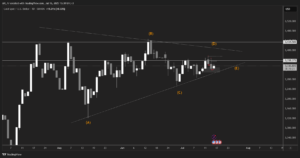The US is expected to have added around 200k jobs in October, and unemployment is expected to rise to 3.6%. A strong non-farm payroll report could support the Fed’s hawkish stance and pull stocks lower.
· GBP/USD dropped 2% after the BoE raised rates by 75 basis points
· The BoE warned rates might not go as high as the 5.25% that the market expects
· Lead indicators suggest that the US labour market remains tight
European bourses closed yesterday firmly lower, except the FTSE, which booked gains of 0.6% thanks to the steep selloff in the pound. Meanwhile, US bourses extended losses on concerns that aggressive hiking by the Federal Reserve could tip the economy into recession.
BoE
GBP/USD dropped almost 2% in the previous session after the BoE raised interest rates by 75 basis points, as expected. However, one of the key takeaways was that BoE Governor Andrew Bailey believed that the market was pricing in peak interest rates well above where they will get to at 5.25%.
Economic growth is expected to stall, and the UK will enter a recession from the current quarter. Slower growth and a recession bring inflation down, and the BoE is now forecasting CPI falling to 5.2% in a year, downwardly revised from over 9% in August. Falling inflation means that the BoE will be required to hike interest rates less aggressively.
This was in stark contrast to the Federal Reserve, which said that it might need to hike rates higher than initially projected in order to tame persistently high inflation, as the US economy proves to be more resilient than the British economy.
GBP/USD fell to a 2-week low of 1.1150, and while the pair is rebounding slightly today, the outlook for sterling remains pretty grim.
NFP
Attention is now turning to the US non-farm payroll. We may have just had the Federal Reserve’s interest rate decision this week; however, with expectations for a December rate hike evenly split between a 50 or 75 basis point rate hike, the report could still create some volatility in the markets. The Fed considers that the jobs market is tight, and today’s data could support those beliefs.
Jobless claims figures have been steadily declining over recent weeks, and the ADP private payroll, which is often considered a lead indicator for the NFP, jumped to 239k, well ahead of forecasts. Job vacancies are still very high, unexpectedly rising to 10.7 million from 10.28 million, and these could keep rising heading into the holiday season when firms often increase headcount.
Expectations are for just over 205k jobs to be added in October. This would be down from 288k added in September, and while it is still a solid number for job creation, it would be the lowest level in 10 months. Meanwhile, the unemployment rate is expected to tick higher to 3.6%, up from 3.5%, and average hourly wages are forecast to rise by 0.3%, in line with the previous month.
A stronger-than-expected jobs report would support the Fed’s hawkish position and could lift the USD higher and act as a drag on stocks. The Nasdaq is on track to lose over 5% across the week.
On the flip side, weaker-than-forecast headline growth, rising unemployment, and a higher participation rate could see the USD reverse its recent rally and stocks rebound.
Disclaimer: This article is not investment advice or an investment recommendation and should not be considered as such. The information above is not an invitation to trade and it does not guarantee or predict future performance. The investor is solely responsible for the risk of their decisions. The analysis and commentary presented do not include any consideration of your personal investment objectives, financial circumstances, or needs.
Sources: Bloomberg, CNBC, Reuters
Original article provided by Trading Writers





